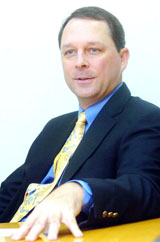Rotterdam Journal
Partying Helps Power a Dutch Nightclub

Robin Utrecht/Agence France-Presse — Getty Images
Movement on the dance floor at Club Watt in Rotterdam, which opened last month, generates electricity used in the light show.
Published: October 23, 2008
ROTTERDAM, the Netherlands — If you felt that the atmosphere in the new hip Club Watt was somehow electric, you would be right: Watt has a new type of dance floor that harvests the energy generated by jumps and gyrations and transforms it into electricity. It is one of a handful of energy-generating floors in the world, most still experimental.
With its human engineering, Watt partly powers itself: The better the music, the more people dance, the more electricity comes out of the floor.
At Watt, which describes itself as the first sustainable dance club, that electricity is used to power the light show in and around the floor. “For this first club, we thought it was useful for people to see the results,” said Michel Smit, an adviser on the project. “But if the next owner wants to use the electricity to power his toaster, it can do that just as well.”
Watt is in large part the creation of the Sustainable Dance Club, a quirky company formed last year by a group of Dutch ecological inventors, engineers and investors now headed by Mr. Smit. More than a year in the making, Watt is a huge performance space with not just the sustainable dance floor, but also rainwater-fed toilets and low-waste bars. (Everything is recycled.) Its heat is harvested in part from the bands’ amplifiers and other musical equipment.
“Our idea is that there’s enough energy in this world, you just have to use it the right way,” Mr. Smit said. “If you have a full dance club, there’s lots there, you just have to turn it into a usable product.”
Greener clubbing will obviously not solve the problem of rising greenhouse gas emissions, which scientists say are responsible for global warming. With their woofers and strobes, nightclubs are electricity guzzlers, unlikely ever to be carbon neutral even if scientists could harness the energy of a mosh pit. (The club’s lights do use low-energy bulbs, however.)
Still, the energy produced by an average person dancing is about 20 watts’ worth, so two people could light a bulb, Club Watt’s scientific consultants have found. Aryan Tieleman, one of the club’s owners, hopes his sustainable dance floor will ultimately produce 10 percent of the club’s electricity. Green innovations at the venue will reduce energy use by 50 percent and water use by 30 percent, compared with the previous club in the building, he said.
The United Nations has said the world must reduce greenhouse gases between 25 percent and 40 percent by 2020 to prevent dangerous warming. Some of that reduction could come from large changes, like the closing of coal-fired plants and better protection of rain forests. But sustainability experts emphasize that much of the gain should come from doing the things everyone does now, but in ways that are a bit more efficient and green.
“The concept is you party like you always do, but here it will be better for the earth,” Mr. Smit said.
Watt is the clubbing equivalent of driving a hybrid.
Customers seem to like it. “Sure, I care about the environment, and I’m happy to do my bit in this way,” said Bas Muller, a student, emerging from bathrooms that feature waterless urinals and rainwater-fed toilets, with tanks that show how many liters are used per flush. Mr. Muller was attending a concert of the Norwegian band Motorpsycho, but had also been at the club in September.
Club Watt, which holds about 1,400 people, is part consciousness-raising, part green-energy experiment — and in large part simple entertainment. (Indeed, Mr. Tieleman offered the British pop singer Amy Winehouse hundreds of thousands of dollars to perform at the club’s opening. It opened without her.)
“The first thing is, I wanted to do my little something for the planet,” said Mr. Tieleman, who decided to build an entirely green club after seeing a presentation by Sustainable Dance Club on the dance floor, which functions through a technology called piezoelectricity.
But he added: “I’ll be very happy with whatever energy the floor produces for the club. And as a businessman, I know it attracts attention.”
Mr. Tieleman spent about $257,000 on the floor, an investment that will not be recouped from the energy it saves, he said, because as a first-generation model it is fairly inefficient. He lends out parts of the roughly 270-square-foot floor for demonstrations. (Part of it will be flown to New York in December.)
It is perhaps natural that this concept has taken off in Rotterdam, a gritty port city with a booming club scene where young residents have a strong vested interest in controlling global warming.
Located at sea level, Rotterdam would be one of the first cities to go under if global ice melted and sea levels rose significantly. And the Netherlands — which has reclaimed substantial tracts of territory from the sea — has gained a reputation for environmental innovation.
In 2006, a group of local architects, academics and engineers was convened by Döll architects and Enviu, an environmental research group, to brainstorm on the eco-club idea. They ultimately created the Sustainable Dance Club company to develop a blueprint for a greener party place that included what they called “spectaculars” (elements like the no-waste bars that customers could see) as well as hidden elements, like a promise to consider sustainability in purchasing.
The most spectacular “spectacular” is, of course, the dance floor. It takes advantage of the piezoelectric effect: certain materials, when squeezed, develop a charge and produce electricity. When people are dancing, the sustainable dance floor yields by about 1 centimeter — less than half an inch — compressing cells containing piezoelectric material underneath.
In theory, piezoelectric floors can take the energy of any step or jump and convert it into electricity, although that process is now expensive and inefficient, converting just a fraction of human energy to usable power. But the technology is evolving, and the world’s first sustainable dance floor is being reprogrammed and electronically adjusted to improve output.
The company hopes to sell the dance floor technology to other clubs and is offering green certification to those that reduce emissions 30 percent. Sustainable Dance Club is now getting an inquiry a day from clubs about the floor.
“You can use it anywhere there’s movement, but the question now is when does it become cost-efficient?” Mr. Smit said, noting that the company was working to develop cheaper, more effective materials.
Energy-generating sidewalks? Subway platforms? Recently, the company identified the next frontier: Gyms and fitness centers.















